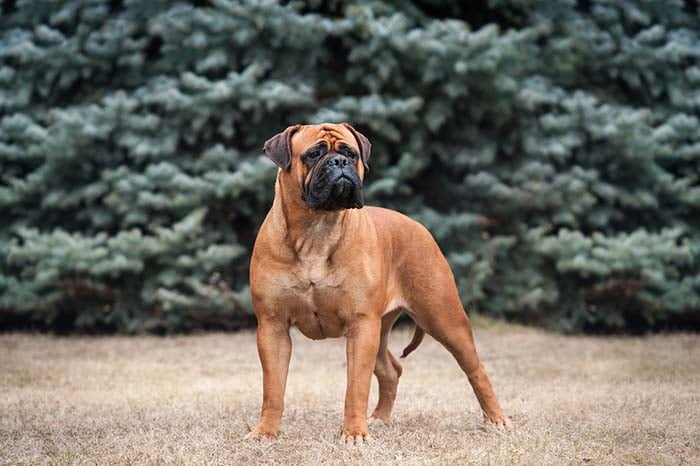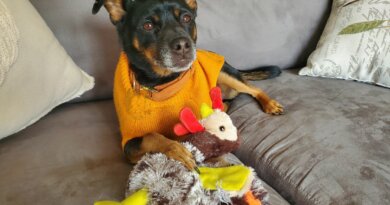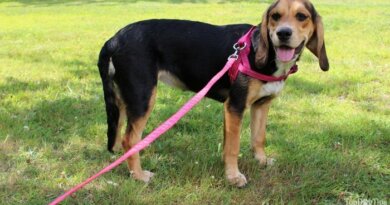Bullmastiff Dog Breed Profile – Top Dog Tips
The Bullmastiffs are gentle and loving guard dogs, making them a great choice for families.
They might have a soft spot for their family but never underestimate the Bullmastiff because they are strong and fearless guardians.
Also known as the “Silet Watchdog,” Bullmastiff is a muscular guard dog who is reliable, intelligent, alert, and confident.
If you plan to adopt a Bullmastiff puppy, you should know that these dogs are not for first-time pet owners.
They are intelligent and physically powerful. They require lots of stimulation and socialization.
This blog will tackle everything you need to learn about the dog breed.
We’ll discuss its physical traits, temperament, training, and exercise needs.
But before that, let’s discuss the Bullmastiff’s history.
Bullmastiff History
Another nickname for the Bullmastiff is “The Gamekeeper’s Night Dog” due to its utilitarian purpose.
The known history of the breed began in 1860 in England.
According to the American Bullmastiff Association, the Bullmastiff dog was bred by British gamekeepers who cross-bred Bulldogs with Mastiffs to create an even larger dog that would listen well to commands and protect their property against poachers.
Poachers cause expensive issues for landowners. The gamekeeper’s job was to catch these thieves.
They needed assistance from dogs that could track quietly, cover short distances quickly, and catch and hold poachers without hurting them.
Gamekeepers experimented with different dog breeds. Mastiff was too slow, and the Bulldog was too ferocious.
With the Bullmastiff, they created a much more agile dog to chase and catch intruders.
They can overpower poachers by pulling them to the ground and sitting on them until the gamekeeper arrives.
Today, the Bullmastiff has become an easygoing, affectionate, loyal companion for families rather than a poacher’s nemesis.
Bullmastiff Physical Traits
Now, let’s check out the Bullmastiff’s physical appearance.
A male Bullmastiff is 25 to 27 inches tall and weighs around 110 to 130 pounds. Females, on the other hand, are 24 to 26 inches and weigh 100 to 120 pounds.
The Bullmastiff has a short and dense coat that’s easy to groom and doesn’t shed excessively.
It also offers good protection from rain, snow, and cold weather.
Their coat comes in three colors: red, fawn, or brindle (a subtly striped pattern that can come in various colors), with a dark muzzle and ears.
They have sturdy, wide legs that support a deep chest, broad shoulders, and sloping hindquarters.
Bullmastiff Temperament
Under the Bullmastiff’s large and muscular physique is an affectionate and loyal companion that loves its family.
Remember that every dog has a unique personality, but most Bullmastiff craves its family’s attention.
However, this behavior doesn’t happen automatically. It requires a lot of training and bonding, which we’ll discuss later further on.
Bullmastiffs have a chill or laid-back vibe with their loved ones but will be alert and cautious with strangers. They are a bit suspicious of people outside the family.
Bullmastiffs are actually quiet pets that don’t bark that much. They are known to be gentle giants.
However, due to their background, Bullmastiffs are excellent watchdogs who respond quickly if they sense potential threats.
Living with a Bullmastiff
Bullmastiff is best suited for homes with a secured, fenced-in area to exercise and play.
They might do well in apartment living as long as they are taken outside for their daily exercise needs.
If you have kids at home, don’t worry because these dogs are gentle with children.
They are patient and protective of children. However, the Bullmastiff is a large dog that still requires overseeing.
As pet owners, we must supervise all interactions between the children and the dog, no matter the breed, to prevent harm from both parties.
Teach children how to approach dogs properly. Tell them never to annoy them or try taking their food away while sleeping.
Training and Exercise
Bullmastiffs are independent thinkers, which can make training hard.
It’s always best to use positive reinforcement training methods rather than fear. Remember that consistency is key when it comes to training.
Bullmastiffs are highly-intelligent pets, so training and socialization at a young age are crucial to these dogs.
Bullmastiffs can get along with other pets, especially if they grew up together and are properly socialized at a young age.
On the other hand, Bullmastiff dogs enjoy their daily dose of exercise.
Others might enjoy a more relaxed day, and some prefer more engaging activities, but a more moderate kind of exercise should be encouraged.
But be careful not to overexercise your Bullmastiff puppies, as it can lead to bone and joint issues.
As Bullmastiff owners, we also must exercise their brains.
Not getting the mental stimulation they need can lead to digging, excessive chewing, or other behavioral problems.
Engaging them in puzzle toys, obedience training, or scent work games can help keep their minds sharp as it challenges their brain.
It can also tire them out as much as physical exercise.
Health Care of a Bullmastiff
The Bullmastiff is a healthy dog breed. Their life expectancy is about 8 to 10 years!
Unfortunately, this mixed breed can be prone to health issues like any other breed.
Owners should schedule regular visits to the veterinarian to keep their health in check.
Hip Dysplasia
Hip dysplasia is a genetic condition wherein the socket of the joint and ball becomes distorted.
If your dog gets diagnosed with hip dysplasia, it’s important to keep their weight within the standard range and have them exercise with activities that encourage joint therapy.
Your vet can prescribe medications for anti-inflammatory, pain relievers, and supplements for this condition.
For prevention, keep them active and ensure they are getting enough exercise but not to the point that they might injure themselves.
Elbow Dysplasia
Like hip dysplasia, elbow dysplasia is a hereditary condition.
One possible cause of this condition is the different growth traits of the three bones that make up their elbow.
Dogs suffering from elbow dysplasia will suffer from painful lameness.
Your vet can recommend surgery to treat and correct the problem and will suggest your pup take medication to control the pain.
Progressive Retinal Atrophy
Progressive Retinal Atrophy, or PRA, is another health condition the Bullmastiff is prone to.
This condition affects the rod and cone cells in the eyes, leading to blindness. Unfortunately, this disease can progress quickly from a year or two.
It is also a hereditary disease known to have no treatment yet. Having your dog’s eyes frequently checked is best advised to reduce the risk of PRA.
Bloat (Gastric Dilation Volvulus)
Gastric Torsion or Bloat is a gastrointestinal condition where-in a dog’s stomach expands due to it teeming with fluid, food, or gas.
This can be a fatal circumstance if left untreated.
Due to bloating, blood is trapped in the stomach, preventing return and proper flow.
Prevention includes not allowing your dog to do activities right after a meal, eating too fast, eating large meals throughout the day, and stressing them.
Treatment may depend on your veterinarian’s observation.
Hypothyroidism
Hypothyroidism is the inactive function of the thyroid gland. Metabolism is slowed down if diagnosed.
The immune system attacks the thyroid gland as it does not recognize it. Usually, this is an inherited disorder.
If the Bullmastiffs are experiencing lethargy, slow heart rate, weight gain, excessive shedding, and high cholesterol, it’s best to have them tested by the veterinarian.
If your Bullmastiff is diagnosed with hypothyroidism, the veterinarian may provide maintenance and recommended diet.
It’s best to have this condition checked and addressed immediately.
Entropion
Entropion is a defect seen as early as six months of age. This health problem causes the eyelid to roll inward, irritating or injuring the eyeball.
Monitor your dog if he is rubbing his eyes because this condition can affect both eyes. Fortunately, entropion can be corrected through surgery.
Grooming
Bullmastiffs have short, dense coats requiring moderate grooming.
Brush your Bullmastiff at least once or twice weekly to remove loose hair and dirt.
These dogs do not demand regular bathing unless they get particularly dirty playing outside or develop an odor.
Check their ears regularly for signs of infection, redness, or wax buildup.
Regular nail trimming is essential to prevent overgrowth, discomfort, and potential injuries.
When trimming their nails, a good rule is never to let them touch the ground.
Regular brushing of your dog’s teeth helps maintain good oral health and prevents dental issues.
Frequently Asked Questions
Are Bullmastiffs aggressive?
Bullmastiffs are usually mild-mannered and obedient dogs.
However, they can get a little aggressive with other male dogs and strangers, as they are excellent watchdogs.
That’s why training and early socialization are required for this dog breed.
Are Bullmastiffs friendly?
Yes, Bullmastiffs are gentle giants that are affectionate and loyal to its family. Generally, these dogs are calm and easy-going pets.
They can also do well with children and other pets if they are properly introduced and socialized.
Are Bullmastiffs smart dogs?
Yes, they are highly intelligent dogs. They are quick learners during training.
If you plan to adopt a Bullmastiff, ensure its brain is also getting the right exercise.
Try using puzzle toys or mentally challenging games such as hide-and-seek or obedience training.
Bullmastiff Dog Breed Profile: Summary
The Bullmastiff is a large and powerful dog breed. It is a mix of two great breeds—Mastiff and Bulldog.
These dogs were bred to be guard dogs in England in the 19th century.
The “The Gamekeeper’s Night Dog” was created to help gamekeepers and landowners catch poachers.
In this day in age, Bullmastiffs are now more laidback or relaxed. They are gentle and affectionate pets, and they love spending time with their families.
These dogs are also highly intelligent and are easy to train. However, they can get a bit stubborn at times.
Overall, if you plan to adopt a Bullmastiff puppy, know they are very protective of their loved ones.
Make sure to properly socialize and train them so that they’ll grow up to be well-rounded dog.
RELATED ARTICLES:










